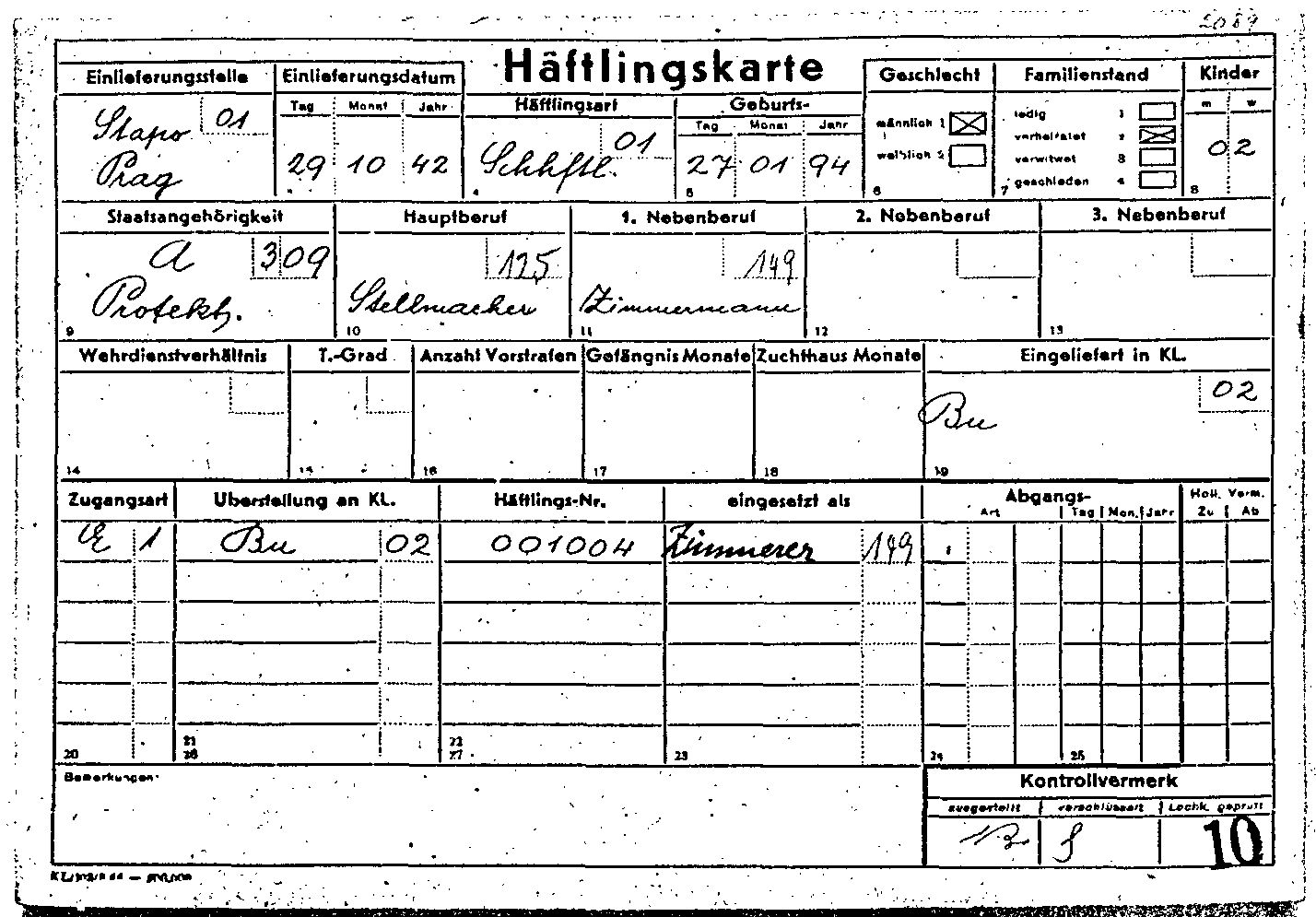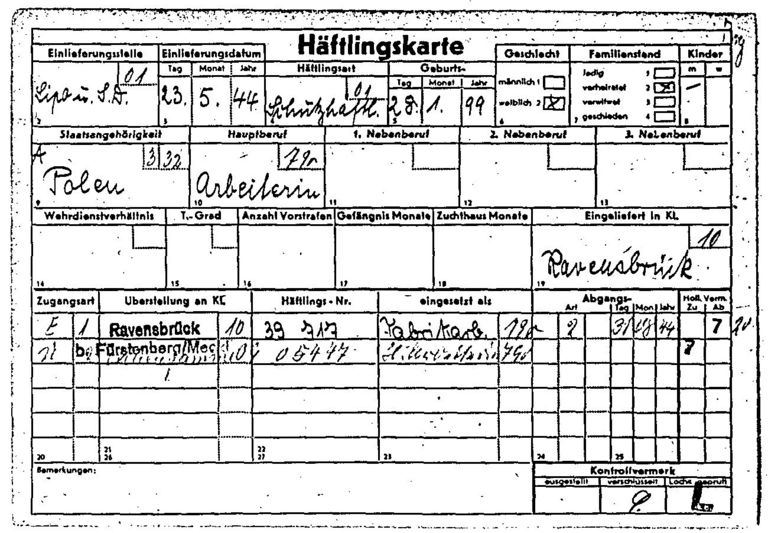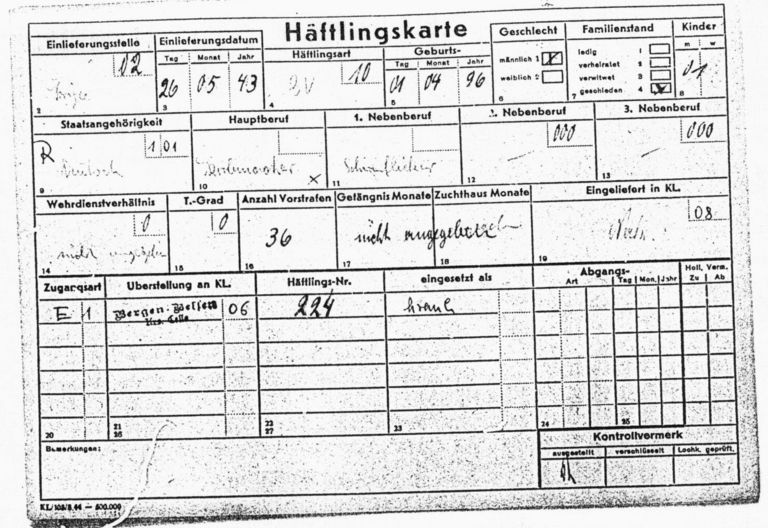Page of
Page /
- Reference
- Intro


This is what is known as a Hollerith preparatory worksheet card. From the summer/autumn of 1944, all concentration camp prisoners were supposed to be recorded centrally using Hollerith tabulating machines so that the SS Chief Economic and Administration Office (WVHA) could plan the prisoners’ labor assignments. Since the preparatory worksheet cards had to be filled out the same way in each concentration camp, the cards are absolutely identical – with the exception of the personal details for each prisoner. The only minor difference is that the camp name was sometimes stamped instead of written to save time.
This is what is known as a Hollerith preparatory worksheet card. From the summer/autumn of 1944, all concentration camp prisoners were supposed to be recorded centrally using Hollerith tabulating machines so that the SS Chief Economic and Administration Office (WVHA) could plan the prisoners’ labor assignments. Since the preparatory worksheet cards had to be filled out the same way in each concentration camp, the cards are absolutely identical – with the exception of the personal details for each prisoner. The only minor difference is that the camp name was sometimes stamped instead of written to save time.
Questions and answers
-
Where was the document used and who created it?
From 1942 onwards, hundreds of thousands of laborers were needed in the German armaments industry and other sectors. The decision was therefore made to use concentration camp prisoners – along with millions of forced laborers – for this work. Office D II of the SS Chief Economic and Administration Office (WVHA) in Oranienburg was responsible for centrally planning the labor assignment of concentration camp prisoners starting in 1942. In early 1944, the former Concentration Camps Inspectorate (Inspektion der Konzentrationslager) decided to use a Hollerith card file system to centrally record the details of all concentration camp prisoners who were “able to work.” The SS was resorting to a well-known technology here, since Hollerith punch cards and reading devices had been used in Germany since the 1930s by many different institutions, primarily to speed up statistical administrative processes. Hollerith machines were capable of quickly processing the data on punch cards and compiling it in lists, making them predecessors of today’s computers.
The Hollerith card file of the WVHA was based on Hollerith preparatory worksheet cards. These were filled out in the Hollerith departments that were established as labor details in the main camps from July/August 1944. In December 1944, for example, 37 prisoner functionaries were placed under the supervision of the labor assignment leader in Buchenwald to carry out this task. After filling out the Hollerith preparatory worksheet cards, they had to draw up a number of lists: labor assignment reports, departure lists, transfer lists and change lists. To update the Hollerith card file, these reports were initially sent daily – and then, from November 1944, every two weeks – to the Maschinelles Zentralinstitut für optimale Menschenerfassung und Auswertung (“Central Mechanical Institute for Optimal Personal Data Acquisition and Evaluation” – or Central Institute for short) in Berlin. This institute, which reported directly to Himmler, assigned the numerical codes for the information on the cards and updated the punch cards on behalf of the WVHA.
- When was the document used?
Hollerith preparatory worksheet cards were created starting in July/August 1944. The first Hollerith department was established in Sachsenhausen in July, and most other camps followed in August; the Hollerith department in Bergen-Belsen was the last to begin work in December 1944. Because prisoners were continually transferred between the main camps and sub-camps and their mortality rates were high on account of the terrible working and living conditions, a tremendous amount of communication was required between the Hollerith departments in the concentration camps, the sub-camps and the Central Institute. It was nearly impossible to keep the Hollerith card file up to date so it was never fully functional. The last cards – with a few exceptions – were created in February 1945. But even by December 1944, not all newly arrived prisoners were being recorded in the card file. Karl Sommer, head of Office D II at the SS Chief Economic and Administration Office (WVHA), was responsible for the labor assignment of concentration camp prisoners. As a defendant in the Nuremberg Trials in November 1946, he mentioned two other reasons why the card file was never really put to practical use: first, it had been created too late, and second, not all of the concentration camps had been involved.
- What was the document used for?
To improve the use of concentration camp prisoners as laborers in the war economy, information from the Prisoner Registration Cards in the concentration camps was transferred to Hollerith preparatory worksheet cards either by hand, by typewriter or sometimes using stamps. Prisoner Registration Cards that had been processed in this way were stamped with Hollerith erfaßt (“recorded by Hollerith”). For prisoners who were admitted to camps later and had not yet been registered, Hollerith preparatory worksheet cards were created as soon as they arrived. The preparatory worksheet cards were only used to record information that was important to the prisoners’ labor assignment, i.e., their age, nationality, professional training and experience, and the camp or external labor detail to which the prisoner was assigned at a particular point in time. The prisoners were identified only by their prisoner number; their names were not noted.
The preparatory worksheet cards were sent by the Hollerith departments in the concentration camps to the Central Institute in Berlin, where employees encrypted them. Each piece of information was assigned a number, and these numbers were then stamped into punch cards. Each punched number in one of the 80 columns on the cards represented a piece of information about the prisoner. If hole 2 in column 6 was punched, it meant the prisoner was female; if hole 1 was punched in column 7, it meant the prisoner was single. The individual concentration camps were also assigned numbers, from 01 for Auschwitz to 12 for Stutthof. Hollerith machines could therefore sort the cards in different ways in order to answer all sorts of possible questions about the prisoners.
- How common is the document?
From July/August 1944 until around February 1945, prisoner functionaries created hundreds of thousands of Hollerith preparatory worksheet cards. Since these were stored in the Central Institute in Berlin, they did not come straight from the concentration camps to the ITS after the war. Instead, the fronts of the cards that had not been destroyed in the war were later copied from other archives. Most of the copies in the Arolsen Archives came from the Polish Red Cross and the German Federal Archives. There are hardly any original cards of this kind in the Arolsen Archives, but there are over 150,000 copies. These “prisoner cards without names,” as they were referred to for a long time at the ITS, can be searched by the date of birth and by the prisoner numbers noted on the cards. Today these cards are sorted by camp, except for individual cases where they were filed in the individual document envelope for a prisoner. The Arolsen Archives have copies of preparatory worksheet cards for prisoners from Bergen-Belsen, Buchenwald, Dachau, Flossenbürg, Gross-Rosen, Mauthausen, Natzweiler, Neuengamme, Ravensbrück, Sachsenhausen and Stutthof.
- What should be considered when working with the document?
Since there are no names on the cards, they are not initially easy to use for research purposes or to clarify the fates of individual prisoners. But if the prisoner number or birth date of a particular person is known, it is possible to search for the cards in the Arolsen Archives. However, as prisoner numbers in particular were often assigned multiple times to different prisoners, other information should be checked as well, such as the prisoner’s date of birth, nationality and even occupation. This can help verify that the card was actually created for the person in question. In 2009, the Brandenburg Memorials Foundation completed a digitization project which was able to assign names to 80% of the cards. This database can be accessed online through the Flossenbürg Concentration Camp Memorial.
When working with Hollerith preparatory worksheet cards, it is important to remember that the backs of the cards were printed as well. Tables that started on the front of the cards (admission type, transfer, prisoner number, etc.) could be continued on the back. However, the backs of the cards were not copied by the ITS. But since the Hollerith data recording process ended shortly after it started, it is likely that very few – if any – of these cards had any information written on the back.
If you have any additional information about this document or any other documents described in the e-Guide, we would appreciate it very much if you could send your feedback to eguide@arolsen-archives.org. The document descriptions are updated regularly – and the best way for us to do this is by incorporating the knowledge you share with us.
Help for documents
About the scan of this document <br> Markings on scan <br> Questions and answers about the document <br> More sample cards <br> Variants of the document

